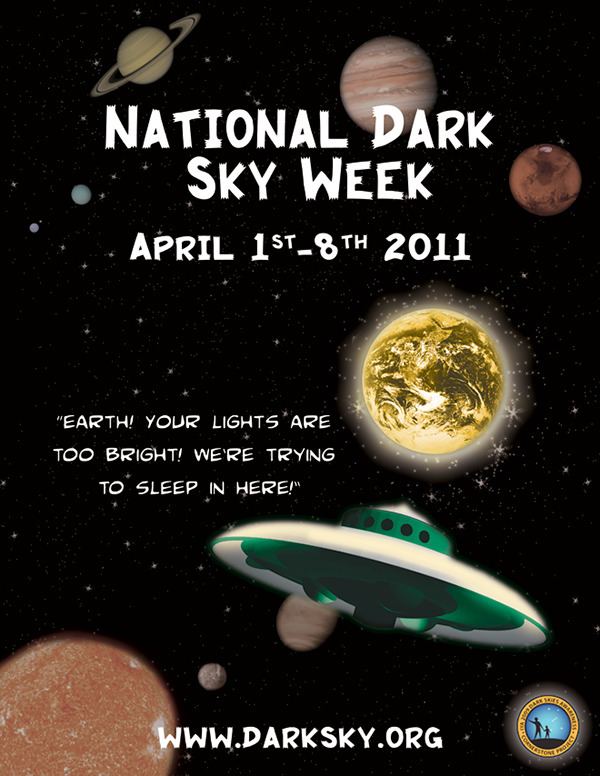Status Active Inaugurated 2003 | Location(s) Worldwide Founder Jennifer Barlow | |
 | ||
Genre Astronomy-related events and competitions Frequency Week of the new moon in April | ||
National Dark-Sky Week (NDSW), held during the week of the new moon in April, is a week during which people worldwide turn out their lights in order to observe the beauty of the night sky without light pollution. This event was founded in 2003 by high school student Jennifer Barlow of Midlothian, Virginia and its popularity and participation increases every year. It has been endorsed by the International Dark-Sky Association (IDA), the American Astronomical Society (AAS), the Astronomical League, and Sky & Telescope (S&T).
Contents
Goal
The goals of the event are to:
This event always occurs in April, during the week of the new moon so that the sky can be as dark as possible for optimum viewing conditions.
Jennifer Barlow states, "The night sky is a gift of such tremendous beauty that should not be hidden under a blanket of wasted light. It should be visible so that future generations do not lose touch with the wonder of our universe." Barlow explains, "It is my wish that people see the night sky in all of its glory, without excess light in the sky as our ancestors saw it hundreds of years ago."
Participation
Willing participants in this project turn off all unnecessary lighting indoors and outdoors sources in order to reduce light pollution of the night sky.
The International Dark-sky Association encourages light users to take precautions against outdoor light pollution by:
Types of light pollution
Light pollution is a broad term used to define excess artificial light that brightens the night sky. Types of light pollution which include:
Implications of light pollution
Light pollution is the adverse effects of artificial light.
Affected parties of light pollution include:
Astronomers:
By increasing the number of participants, the quality of viewing the sky and stars will be temporarily improved. This is a benefit to astronomers that are faced with light pollution issues such as light trespass and skyglow.
Nocturnal wildlife:
Several animal species have been documented to be affected by light pollution. The glare of street lights cause distraction to nocturnal birds in flight leading to bird crashes into sky scrapers and buildings. The use of light may also cause birds to reproduce or migrate too early. The feeding behavior of insects, bats, sea turtles, fish, replies reflect alterations by artificial light. Sea turtles mistake the glow of electric lights for the shimmer of the ocean, leading them to flock outside of their nest into hazardous areas.
Human circadian rhythm and sleep patterns:
Exposure to light during traditional sleeping hours have are documented to cause disruptions in the circadian rhythm that regulate human sleep cycles. Biologists have noted a decrease in the amount of melatonin, a natural hormone that regulates the Circadian rhythm, in humans that are exposed to light pollution of the night sky. In order to prevent major impact, biologists suggest to increase the amount of natural light exposure during the day and decrease the amount of electrical light consumed at night.
Growth patterns of plants and trees:
The growing pattern of trees have been disrupted and less adjusted to seasonal changes in weather and light exposure.
Waste of economic resources:
Leaving lights on that are not in use can lead to the waste of economic cost expenditures. Conservation and efficiency is necessary for environmental responsibility. The invention of LED lights, dimmers, motion sensors and times have reduced the amount of energy used.
Legislation
The best way to take action to promote dark skies is to get involved in local government. There are templates for light ordinances that can legally ban the use of harmful lights and limit commercial lighting to a specific curfew. Currently, there are no nationwide standards regarding light pollution. However, select cities across the United States and Canada are taking initiative to facilitate dark sky cities in order to reduce light pollution and view the night sky within city limits.
